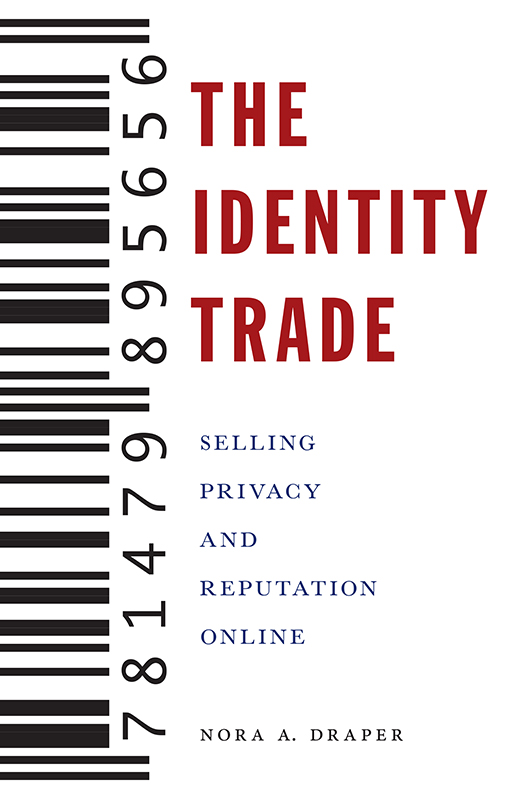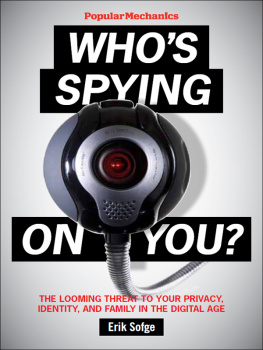
The Identity Trade
CRITICAL CULTURAL COMMUNICATION
General Editors: Jonathan Gray, Aswin Punathambekar, Adrienne Shaw
Founding Editors: Sarah Banet-Weiser and Kent A. Ono
Dangerous Curves: Latina Bodies in the Media
Isabel Molina-Guzmn
The Net Effect: Romanticism, Capitalism, and the Internet
Thomas Streeter
Our Biometric Future: Facial Recognition Technology and the Culture of Surveillance
Kelly A. Gates
Critical Rhetorics of Race
Edited by Michael G. Lacy and Kent A. Ono
Circuits of Visibility: Gender and Transnational Media Cultures
Edited by Radha S. Hegde
Commodity Activism: Cultural Resistance in Neoliberal Times
Edited by Roopali Mukherjee and Sarah Banet-Weiser
Arabs and Muslims in the Media: Race and Representation after 9/11
Evelyn Alsultany
Visualizing Atrocity: Arendt, Evil, and the Optics of Thoughtlessness
Valerie Hartouni
The Makeover: Reality Television and Reflexive Audiences
Katherine Sender
Authentic: The Politics of Ambivalence in a Brand Culture
Sarah Banet-Weiser
Technomobility in China: Young Migrant Women and Mobile Phones
Cara Wallis
Love and Money: Queers, Class, and Cultural Production
Lisa Henderson
Cached: Decoding the Internet in Global Popular Culture
Stephanie Ricker Schulte
Black Television Travels: African American Media around the Globe
Timothy Havens
Citizenship Excess: Latino/as, Media, and the Nation
Hector Amaya
Feeling Mediated: A History of Media Technology and Emotion in America
Brenton J. Malin
The Post-Racial Mystique: Media and Race in the Twenty-First Century
Catherine R. Squires
Making Media Work: Cultures of Management in the Entertainment Industries
Edited by Derek Johnson, Derek Kompare, and Avi Santo
Sounds of Belonging: U.S. Spanish-language Radio and Public Advocacy
Dolores Ins Casillas
Orienting Hollywood: A Century of Film Culture between Los Angeles and Bombay
Nitin Govil
Asian American Media Activism: Fighting for Cultural Citizenship
Lori Kido Lopez
Struggling for Ordinary: Media and Transgender Belonging in Everyday Life
Andre Cavalcante
Wife, Inc.: The Business of Marriage in the Twenty-First Century
Suzanne Leonard
Dot-Com Design: The Rise of a Useable, Social, Commercial Web
Megan Sapnar Ankerson
Postracial Resistance: Black Women, Media, and the Uses of Strategic Ambiguity
Ralina L. Joseph
Netflix Nations: The Geography of Digital Distribution
Ramon Lobato
The Identity Trade: Selling Privacy and Reputation Online
Nora A. Draper
The Identity Trade
Selling Privacy and Reputation Online
Nora A. Draper

NEW YORK UNIVERSITY PRESS
New York
NEW YORK UNIVERSITY PRESS
New York
www.nyupress.org
2019 by New York University
All rights reserved
References to Internet websites (URLs) were accurate at the time of writing. Neither the author nor New York University Press is responsible for URLs that may have expired or changed since the manuscript was prepared.
Library of Congress Cataloging-in-Publication Data
Names: Draper, Nora A., author.
Title: The identity trade : selling privacy and reputation online / Nora A. Draper.
Description: New York : New York University Press, [2019] | Series: Critical cultural communication | Includes bibliographical references and index.
Identifiers: LCCN 2018021495 | ISBN 9781479895656 (cl : alk. paper)
Subjects: LCSH: Internet industryUnited States. | PrivacyUnited States. | Data protectionUnited States. | Consumer protectionUnited States. | Information technologySocial aspectsUnited States.
Classification: LCC HD9696.8.U62 D73 2019 | DDC 381/.142dc23
LC record available at https://lccn.loc.gov/2018021495
New York University Press books are printed on acid-free paper, and their binding materials are chosen for strength and durability. We strive to use environmentally responsible suppliers and materials to the greatest extent possible in publishing our books.
Manufactured in the United States of America
10 9 8 7 6 5 4 3 2 1
Also available as an ebook
Contents
For my grandparentsJoyce, Rich, Frank, and Eleanor
Framing the Consumer Privacy Industry
From PRISM and the Edward Snowden scandal to the arrival of Google Glass, 2013 was the year that the desire to be seen and heard was turned on its head. Consider the following: in January, the TSA scrapped airport body scanners that produce near-naked images of travelers; in June, Edward Snowden revealed the widespread global-spying program, Project PRISM; in October, Google announced new privacy policy plans that allow the company to incorporate user data into advertisements. The discussion of privacywhat it is and what it isntembodies the preeminent concerns of 2013. For this reason, privacy is Dictionary.coms Word of the Year.
selfie noun, informal (also selfy; plural selfies). A photograph that one has taken of oneself, typically one taken with a smartphone or webcam and uploaded to a social media website.
Today Oxford Dictionaries announces selfie as their international Word of the Year 2013. The Oxford Dictionaries Word of the Year is a word or expression that has attracted a great deal of interest during the year to date. Language research conducted by Oxford Dictionaries editors reveals that the frequency of the word selfie in the English language has increased by 17,000% since this time last year.
In 2013, I came across several social media posts juxtaposing the selections of privacy and selfie as words of the year by Dictionary.com The selection of these terms in the same year, therefore, raises a question: how can a society that is deeply implicated in cultures that encourage self-promotion and information sharing be simultaneously preoccupied with anxieties about overexposure and unwanted observation?
This tensionbetween impulses to share and anxieties about losing control over personal informationwas highlighted in 2014 when an illegal hack of Apples iCloud servers resulted in the publication and circulation of a trove of personal photographs. Although successful hacking efforts often receive news coverage, the inclusion among the stolen images of selfies taken by female celebrities, some of which depicted the women without clothing or in revealing outfits, generated immense public interest. The incidentknown alternately as celebgate and the fappeningprovoked public debate about the responsibility of image sharing platforms that were trafficking in these stolen photos. The resulting conversations contributed to ongoing debates about where and how to allocate responsibility and blame for failures to properly safeguard personal information in the digital age.
The celebgate incident clarifies the intimate connection between the cultural trends that resulted in privacy and selfie being selected as lexical exemplars in the previous year. Although selfies are visual artifactsdefined in part by their circulation through digital networksnot every selfie is intended as a public document. Expectations about the visibility of images stored on private servers or circulated in a specific network are informed by assumptions about the boundaries of those spaces. Taking a picture does not confer consent for that image to be viewed by others, just as sharing an image with a person or group does not grant rights for unlimited public visibility. Although we may not consider selfies circulated among friends or posted on social network sites to be private, we may nevertheless wish to limit how these images are accessed and by whom.
Next page










